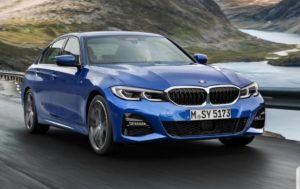
THE 2019 BMW 3 Series.
image from BMW | image from BMW
The outgoing 3 Series, code named F30, was a highly successful model like the model before it, the E90.
Even to its final production year, demand for it was still very high.
Amongst its newer rivals, it was still the benchmark model, surpassed only by a very small margin when the new Jaguar XE compact sport sedan was introduced in 2017.
So even for an older car going head to head with an all-new model and acing it, is quite a fete for a 7-year-old model.
The 3 Series is the epitome of “compact luxury sports sedan.” It has 40 years of heritage, 40 years of practice and getting the formula right, 40 years of experience in getting the “compact luxury sports sedan” formula correct.
What I love about the 3 Series is that from one generation to another, the design is always almost evolutionary.
BMW does not want to mess around with the design of the 3 Series as this is its best selling product. This is BMW’s bread and butter to say the least. So getting it right is very important for BMW.
So good in fact that BMW sold over 5 million units of 3 Series in its 40 years of production. 1 out of 5 BMW sold around the world is a 3 Series. This is, by far, BMW’s most important vehicle and it has its own cult following.
There are a few things to remember that are inherent of a 3 Series. Without these characters, it would not be a BMW 3 Series at that.
The bold kidney grill, BMW’s hofmeister kink (a low, forward bend at the C pillar), great balance of good handling, ride comfort and driving dynamics, and starting with the E46, the L shaped tail lights.
The L shaped tail lights has always been a hallmark design of other BMW sedans in the past and current models like the 5 series and 7 series. But for the 3 Series, it only started in the E46 (from 1999 until 2005) that the 3 series got its L shaped tail lights. The E90 got its L shaped tail light after its mid life refresh sometime 2010 as the E90 LCI.
There have been so many speculations about the design of the G20 3 Series. Renderings and spies photos about this all new BMW 3 Series started to appear three years back (before it was officially revealed) that you would believe anything that you would see online.
Some were really good and believable, but others were just a piece of crap. But with the latest photos, photos that had camouflage on it suggests that the new design closely resembles to that of the new 5 Series.
And true enough, when the G20 BMW 3 Series was officially revealed, it retained the design language of the 5 Series albeit in a shorter wheelbase and in a much compact dimension.
Oh no, don’t get me wrong, the all new 3 Series is not small. In fact, this is the biggest 3 series of all times, it’s as big as the 1995-2003 BMW 5 series (E39). Now that says a lot about this new 3 series cabin space. So, dimensions have grown bigger but thankfully, with the use of new lightweight saving materials and clever production processes, the new 3 series are also 55 kilos lighter and 40 percent stronger compared to the outgoing model.
This means that new BMW 3 series is more fun to drive as it’s easy to toss around in corners, engines are more efficient as it carries less weight and will have a better driving dynamics overall.
Engine options for the G20 BMW 3 Series include Twin Power Turbo 4 cylinder diesel engines and Twin Power Turbo 4 cylinder gasoline engines, all mated to a new 8 speed automatic transmission.
But the most popular engine of choice has always been the 2.0 li 4 cylinder turbo diesel engine found in the 320d variant. It’s powerful at 190hp with close to 400nm of torque and very practical with very minimal fuel consumption and low carbon foot print. It’s the most practical engine of choice for many 3 series buyers and will likely to be the best seller in the 3 Series variant.